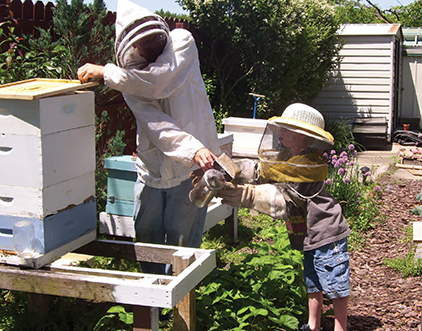
I am a 100% chemically-free beekeeper when it comes to varroa control in my apiaries. Does that conjure up images and thoughts of a totally disconnected bee-haver doing no management other than taking what honey my bees are fortunate enough to make? Apiaries with hives simply left to their fate and allowed to collapse, sending out varroa bombs, SHB bombs, herds of wax moths and disease-ridden bees into the area? If so, you are very much mistaken.
And to anyone who calls them self a treatment-free beekeeper and engages in this hands-off approach, don’t think I’m going to justify your neglect and the possibility of you spreading your problems to those around you. You could not be further from the truth, for I don’t even consider you a beekeeper.
This will be my 52nd year of keeping bees. Thanks to the Boy Scout Beekeeping merit badge and the good fortune of a competent, and unique, mentor I received the most thorough introduction and education in beekeeping one could hope for, with the exception of some current university programs. If you doubt the effectiveness of the BSA program, look up the requirements I had to complete before taking possession of my first hive. How many of those requirements did you complete before you were handed bees?
I was fortunate enough to experience the last days of a better era of beekeeping and watched as a seemingly endless progression of new problems began to unfold starting with chalkbrood, then mites, viruses, CCD, a new nosema, SHB, phorid flies. Who knows where it will end?!
Of all these man-made problems, varroa has been the one that most damaged my bees, caused me to change my practices and took some of the enjoyment out of beekeeping. Jerry Hayes, Randy Oliver, and the other regular writers for ABJ are absolutely correct that this is a key issue currently facing bees, beekeepers and the beekeeping industry.
It should not be; a small, blind and basically helpless mite that causes little damage on its original bee host has brought bees, beekeepers, and beekeeping to their collective knees. How did this come to be? Unfortunately, Jerry is right; we are the problem. We have brought this mite upon ourselves and our bees, then unwittingly aided it in its conquest of our hymenopteran allies. The responsibility to correct this problem lies with us, as we have brought it about.
I first noticed varroa in my hives in the 90s. Previous experience with bee diseases and treating other diseased or pest-infested plants and animals had taught me that medications, used properly and timely, would cure many of these ailments. So when the beekeeping industry was given access to chemical treatments for mites I began using them along with just about every other beekeeper. (I was also aware of what happens if these were used inappropriately or without need—the label is the law.)
Still colonies collapsed and perished. Some would occasionally last 2, maybe 3, years at the most, but eventually they too fell by the wayside. Even those lasting more than a year were not healthy like bee colonies that I was used to in the past. And queens, which could have been counted on for a couple of years of productivity, suddenly were having difficulty getting through a single year.
I was on a yearly routine of cleaning out dead-outs, ordering new bees, and treating for mites. Excess honey, if any, was becoming something the bees struggled to produce. And then there appeared bees with deformed wings. Varroa had enabled several previously not so problematic bee viruses to escalate.
Most disturbing to me, as someone who truly cares about the health and well-being of my bees, was the revelation that the chemical agents we were using to control mites were bringing about sublethal effects on our bees, synergizing with other chemicals in the hive and creating a chemical witch’s brew, creating stronger, more resistant mites and generally damaging and weakening our bees.
Tiring of the merry-go-round and banging my head against a brick wall, the words of G. H. Cale and W. C. Rothenbuhler at the end of Chapter 6 in my 1978 copy of The Hive and the Honey Bee kept surfacing in my mind: “We can have greatly improved bees if we want them sufficiently.” Also, Malcolm T. Sanford’s words in CIR766 Diseases and Pests of the Honey Bee: “each beekeeper must necessarily become a ‘breeder of bees’ ” and “it is also a myth that better stock exists elsewhere.”
Exactly how to go about doing this was the first question needing answered. Cale and Rothenbuhler stated “It is a matter of devoting time, intellect, and material resources to the necessary research and development.” Sanford advised proceeding by “continually judging by trial and error how certain bees fit” the beekeeper’s operation.
Neither suggestion offers a clear blueprint of how to proceed. I’d tried about every strain of bee available from the 60’s on in both the ABJ and Bee Culture. Another memory surfaced of a plan for breeding, selection and improvement that I came across in my copy of Genetics for Aquarists by Dr. J. Schroder. I had put this plan to use with aquarium fish. I also knew that if natural selection were allowed to proceed without any involvement or interference from us, bees and mites would come to an “equilibrium,” as Marla Spivak put it, a balanced host-parasite relationship.
After cleaning out my dead-outs in 1996, and being left with no living hives, I ordered two packages, hived three swarms and one cut-out. I decided not to treat for mites and see what happened. One package colony and the cut-out died that winter. The 3 swarms were in terrible shape and two perished in a severe cold spell in early spring. The remaining infested swarm colony was destroyed (explained later). At that time I was not doing any mite counts, but it was obvious what ….


